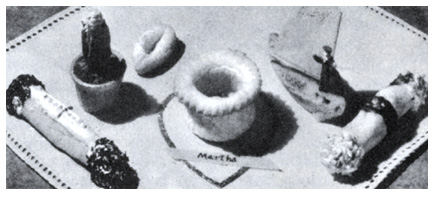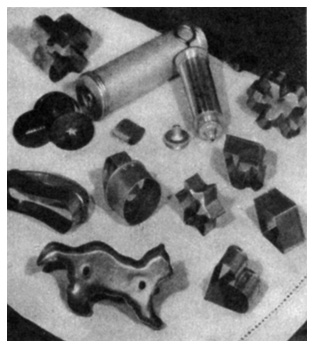It is not by luck alone that a woman becomes a successful hostess…
Wish you could re-create a classy entertaining experience from the 1930s? You’ve come to the right place.
Follow our series on Color Scheme Parties and delight your guests with a new twist in decoration, novelty in menu ensemble, style and color combination in food… to say nothing of the extra-delicious recipes!
There are separate sections on the following color schemes: Rainbow, Rose or Pink, Yellow, Brown and Orange, Green, Red and Green, Red, and Lavender. Additional sections cover the subjects of Children’s Parties, Bridge and Bunco Parties and the Sandwich Shoppe.
Any kind of party imaginable will come under one of these sections, or a combination of two or more of them, such as Green-and-Gold, etc. There are 18 menus and 200 new and different recipes!
For now, here are some authentic 1930s decorative suggestions to get you started!
Flowers and Candles
 Despite passing fads for artificial flowers of paper, glass or wax, fresh cut ones are the thing for nicety in entertaining. Except for tall, slender candles, the chin line of persons seated about the table should be the top line of flowers or other decoration. Nothing is more disconcerting to guests than a floral barrier.
Despite passing fads for artificial flowers of paper, glass or wax, fresh cut ones are the thing for nicety in entertaining. Except for tall, slender candles, the chin line of persons seated about the table should be the top line of flowers or other decoration. Nothing is more disconcerting to guests than a floral barrier.
Candles properly used are most charming. Colors are permissible to match the general color-scheme or blending with it. The very latest in the use of candles is illustrated here – a tall one inserted in the center hole of the low flower bowl, with flowers arranged artistically around it. Candles should not be lighted before four o’clock, but must be lighted if used on the dinner tables.
At Christmas time and other festival occasions it is customary to have made-up centerpieces for the table. These are sometimes developed by the artistic use of actual food, such as the tiered wedding cake, the filled pumpkin or horn of plenty, etc.
Linens
White linen is always fight for formal entertaining, although the newer vogue for color has invaded even this field. Care must be used in introducing colored cloths, however, for the effect will be tragic unless artfully blended with china and glassware. There continues to be nothing handsomer for the strictly formal tea or reception than an exquisitely designed, hand-made lace cloth.
Informal use favors card-table covers of appropriate design and miscellaneous fabric’ luncheon sets of futuristic cut and decoration; small white or colored cloths of linen or crash, even of paper or fabricoid. The informal dinner or luncheon table, when not dressed as mentioned above, may have simple white or colored linen cloths.
For picnics, children’s parties and indoor church or lodge groups, paper or fabricoid covers have the edge on cloth, and may be purchased in modernistic design, varicolored or to match any desired color-scheme.
Dishes
Formal dinner service demands good china of some not too conspicuous pattern. Crystal or galassware of rainbow tints is popular when combined with dinner sets. An extremely new black-and-white modernistic type of dinner-ware is also most attractive.
informal service looks with equal favor upon the orthodox china or the novelty of latest mode in pottery. Glassware is often used exclusively, especially for breakfasts, bridge or club parties where food service consists of salads, a la kings and similar lighter entrees.
Favors
Favors may be of glass, paper or edible material – snappers, boats, flowerpots, candle-holders, etc., may all be made of cake and candy and frosting, and most attractively, too.
Completely edible favors are made from pastry dough, cake or cookie dough and combined with the necessary paper, toothpicks and decorative figures. (see illustration)
 Place cards, in the edible style, are simply cookies which are frosted and then marked with the name or initial in softened sweet chocolate.
Place cards, in the edible style, are simply cookies which are frosted and then marked with the name or initial in softened sweet chocolate.
Bon bon cups, edible, are made of sweetened pie dough, rolled quarter inch thick, baked on backs of muffin pans. Separate circles of the pie dough are cut and baked for the frill, which is placed on top of the cup with frosting. The cup and frill may both be finished with colored frosting to match a color-scheme if desired, filled with suitable candies or nuts, and placed on a paper place card to prevent greasing the tablecloth.
Snappers, such as children adore, made of sweetened extra-rich pie dough, are interesting. Small piece of dough is rolled in the hands thill three-quarters inch thick and four inches long, then baked 10 minutes at 450°. When cool, each end is dipped in colored frosting, then in cake candies or colored sugar.
Flowerpots are made of chocolate cake batter dropped into paper or ice cream cone cups, and baked. when cool, scatter nuts or candies over each, and insert the tooth-pick with the “flower”, made of frosting and previously dried.
Sail boats are made of cake baked in shallow pans, cut in boat shapes when cool. Frost top and sides, outline deck with line of melted sweet chocolate and finely chopped nuts. Make sail of paper, thread and toothpicks.
Cake Pans
Springform cake pans are helpful for Ice Box Cakes and for large, single-layer cakes. Then there are hearts, crescents, diamonds, ovals and stars for fancy cake-parties, showers, Mother’s Day, St. Valentines’s Day, bridge and lodge parties.
Individual cake pans come in all such forms, too. Shell pans, with depressed centers for filled cakes, puddings, salads and main dishes are available in large or individual sizes.
Cutters and Fancy Molds
 Cookie cutters are invaluable for party cookery – used for sandwiches, biscuits, French pastry and petit fours as well as cookies. animal cutters are also available.
Cookie cutters are invaluable for party cookery – used for sandwiches, biscuits, French pastry and petit fours as well as cookies. animal cutters are also available.
The cookie pump comes with different tubes, and is used like a frosting tube, to handle soft cookie doughs. Fancy-shaped cookies, such as pretzels, twists or alphabet cookies, are thus possible.
Fancy molds for attractive table service may be purchased – animal shapes, star designs, shells and regulation paddles for making balls or roses.
For salads and desserts and ice cream, molds may be purchased in many forms, individual or large sizes.






